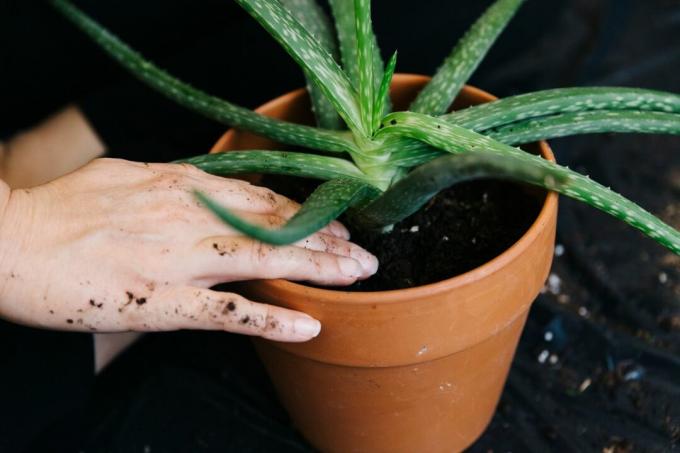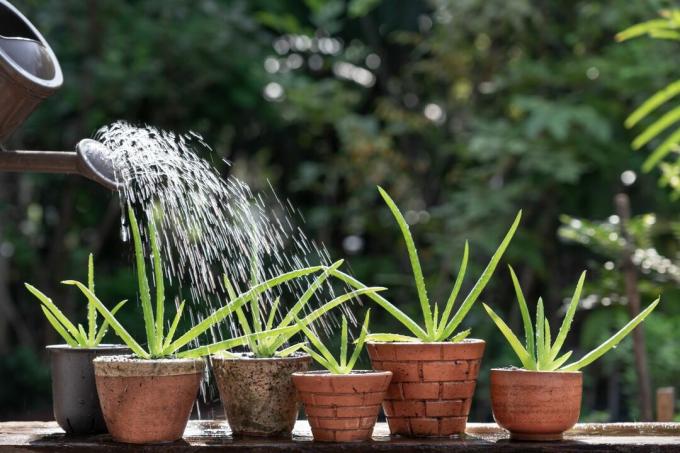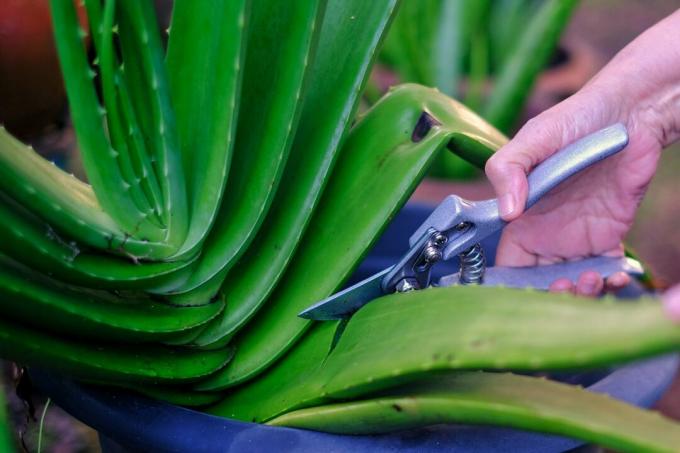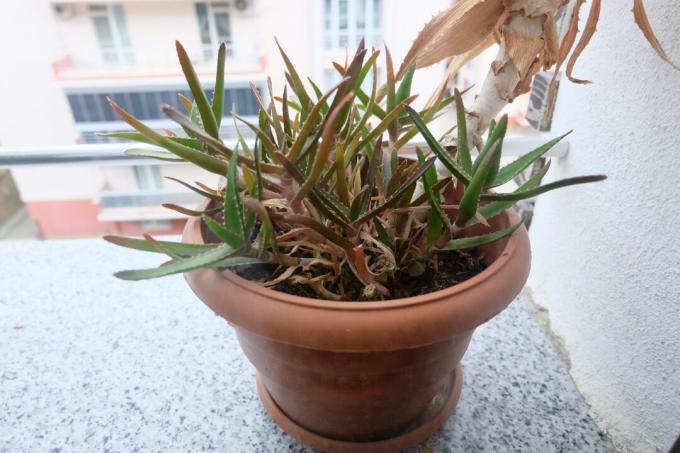the aloe vera can be used in many ways as a decorative and medicinal plant. But how do you properly care for them? Read everything about watering, fertilizing and cutting the succulent with us.

the aloe vera used by many people as a medicinal or green plant. When it comes to care, however, some background knowledge is required so that the plant grows healthy and strong. We'll tell you how aloe vera care properly.
contents
- Aloe vera care: Water aloe vera
- Fertilize aloe vera
- Cut aloe vera plant
- Aloe vera turns brown: what to do?
Aloe vera care: Water aloe vera
As a succulent, the aloe vera able to store water in their leaves and tolerate drought for long periods of time. Therefore, compared to many other indoor plants, it rarely needs water and is sensitive to waterlogging. The substrate should nevertheless be kept permanently moist and not dry out completely. Will the aloe vera poured without the water being able to drain off, the soil aeration is inhibited by the water saturation and root rot can occur.
In rosette-forming plants such as the aloe vera it is also important not to let the water run over the leaves when watering. Otherwise water can accumulate in the heart of the rosette - this promotes fungal infections and can lead to the plant beginning to rot. Best suited for the aloe vera Lime-poor water, such as rainwater or mineral water.
But how often should you aloe vera to water? It is usually sufficient to water them once a week. The right time can be determined by finger testing: When the surface of the earth is dry, you can water again.

Increased caution is required with young plants, because the leaves cannot yet store as much water as those of older plants. They should therefore be watered more frequently, but with smaller amounts of water.
Since the aloe vera In our part of the world, because of the cooler climate, it goes into hibernation, it is important to adjust the watering rhythm of the plant. In its cool winter quarters, it should only be watered occasionally so that the root ball does not dry out. The risk of root rot from over-wetting is higher during the winter as the aloe vera does not absorb as much water as during the vegetation phase.
Fertilize aloe vera
the aloe vera originally comes from the desert-like, hot regions of the Arabian Peninsula. There the nutrient supply of the plant is only possible to a very limited extent. It therefore naturally needs little fertilizer. Nevertheless, an occasional fertilization of the aloe vera useful, especially if it is used as a medicinal plant. She then recovers better from a cut and produces strong, healthy leaves with lots of gel.
During the growing season it is therefore good that aloe vera to fertilize about every two weeks via the irrigation water. In this way, the nutrients that are important for the plant are better distributed in the soil solution, are available more quickly and ensure healthy and vigorous growth. For example, our is suitable for this Plantura organic indoor and green plant fertilizer. This has, in addition to a balanced nutrient composition and a resource-saving, lower phosphorus content, via additional microorganisms to better utilize the nutrients from the substrate be able. Because of its completely organic and animal-free production, it also protects the environment and the climate.
Immediately after repotting you have to aloe vera do not fertilize, as the nutrient reserves of the fresh soil are still sufficient to supply the plant. Fertilization of the plant is also not necessary during the hibernation between October and April.
Cut aloe vera plant
A care cut is at the aloe vera not necessary. If you want to keep your plant in shape so that it doesn't grow too large or sprawling, you can cut off the outer, old leaves if necessary. Diseased or damaged leaves should also always be removed.
If you want to use them as a medicinal plant, you should regularly remove the outer leaves of thealoe vera to harvestto use the gel. Plants that are more than three years old are particularly suitable for this - their leaves are larger and more vital than those of younger plants. They have more gel, recover better from harvest and grow new leaves faster.

Aloe vera turns brown: what to do?
Sometimes the leaves of the aloe vera turn brown, greyish-purple or pale. This can be for a number of reasons: If the outer, older leaves are turning brown, there is no need to worry. The plant continues to develop, shedding the older leaves and forming new ones inside.
Sometimes the leaves also change color immediately after repotting - that's not a problem either. the aloe vera just takes some time to grow into the new substrate and the discoloration will go away on its own.
If the aloe vera If the plant has not been repotted for a long time, there may be a lack of nutrients in the old substrate, causing the leaves to turn brown. By repotting early, the plant is then supplied with nutrients again.
A reddish to brownish coloration can be a reaction to too much direct sun as the aloe vera so can protect. If the leaf tips are additionally dry, it is time to aloe vera move to a less sunny spot. The leaves will then take on their strong, green color again after a short time.

It is more problematic if none of the problems described above can be identified and resolved. Especially if the inner, younger leaves also turn brown or turn yellow, this can be an indication of too much water. the aloe vera As a succulent, it is able to store large amounts of water in its leaves, but does not tolerate waterlogging very well. At the latest when the aloe–vera-Leaves become soft when squeezed between fingers, backwater should be discarded and watering stopped completely for a week or two. Discolored, soft leaves can be cut off and disposed of as they offer a good surface for fungi to attack.
The most common reasons for brown leaves on the aloe vera:
- growth: Young leaves follow, old leaves can be removed.
- repot: Sometimes the aloe vera brown immediately after repotting, fine roots must first be formed, then the aloe will become vital again by itself.
- Old substrate: There are no more nutrients in the substrate that aloe vera should be repotted soon.
- Too much sun: Stands the aloe vera too long in direct sun may result in brown leaves for sun protection. It should be moved to a more sunny location.
- waterlogging: If watered too much, the leaves may turn brown and soft. Watering should be stopped completely for 1 to 2 weeks to allow the root ball to dry out. Caution: Danger of rot and fungal attack.
You can find out more about the origin of the plant, its overwintering and the right potting soil in our further article, which deals with the location, planting and propagation of the aloe vera occupied.



